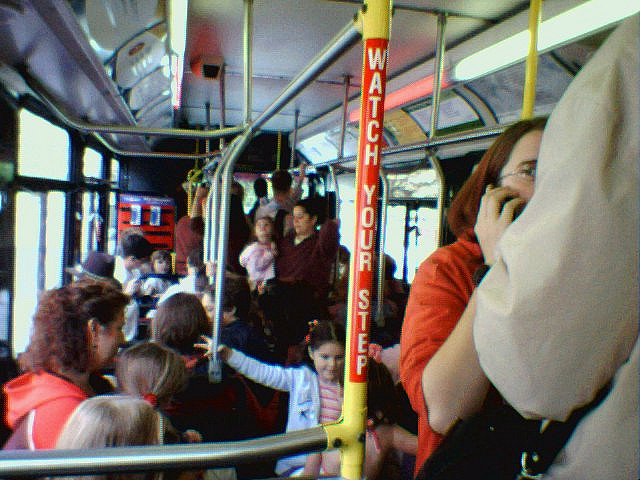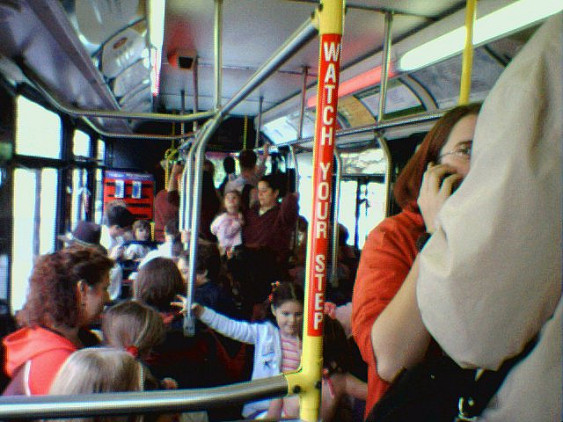Portland’s transit agency is considering giving riders a perk that nearly no other in the country offers: the ability to board a bus or train and ride anywhere in the system for three hours before having to pay another fare. It’s also analyzing whether it could afford to allow riders to take unlimited trips on a single ticket after 7 p.m.
This generous transfer policy would benefit low-income and cash-paying riders, such as a transit-dependent mom who runs errands and “chains” trips together on the bus or a hotel night shift worker who could commute more economically.
On the other hand, it would also benefit wealthy and occasional riders who hop on the MAX to a Trailblazers game, who are financially more than able to buy a $5 day pass but would be able to complete their round trip for just $2.50. (For more background, read our earlier post.)
A long string of service cuts and fare increases have led Portland-area riders, particularly those who live in lower-income neighborhoods and communities of color, to agitate for a 3-hour transfer window and unlimited night service. TriMet has listened and is currently analyzing how much the transfer changes would cost.
To do this, TriMet has to estimate losses from existing customers who could make round trips on a single fare and predict how much additional revenue might flow into the system from new customers who now find the bus a more attractive option. But there are reasonable disagreements about the assumptions that feed the models that transit agencies use to do these calculations.
Another challenge is that there are few comparable cases, since most transit agencies offer no more than two-hour transfers and some only allow riders to use them in one direction. However, two cities—Minneapolis and Dallas—have instituted unusually liberal policies that allow riders to travel for longer chunks of time on a single, affordable fare. Though the systems and policies aren’t seamlessly comparable, we checked in with those two transit agencies to see what lessons Portland might take away.
Minneapolis/St. Paul
Minneapolis/St. Paul has one of the most generous transfer policies in the country, giving customers unlimited round trips for 2.5 hours on a single ticket purchase. Before 1998, riders could only use transfers in one direction (meaning they couldn’t go somewhere and come back on the same fare). That year, the agency loosened its policy, in part to test whether customers would choose the bus more often if they could accomplish short trips on a single fare, according to Bruce Howard, director of customer service and marketing for Metro Transit.
In the two years following the change, the agency saw an astounding jump in ridership—6.9 percent and 8.7 percent, respectively—that was markedly higher than other years before or after. But because the agency also made other changes around that time, like adding night owl service and making other expansions, it’s difficult to say how much of the bump can be attributed to any one factor.
However, in the first three months after instituting the 2.5 hour transfer, the agency did see an increase in original boardings (up 2 percent) and in transfers (up 32 percent), which suggests that the policy did encourage some additional ridership. As for lost revenue from customers who previously paid double for the same ride, Howard said the agency felt the additional trips and ancillary benefits—making transit more affordable for the transit-dependent, making it more attractive to visitors, improving boarding time, and reducing fare confrontations with operators—would offset those costs. As he remembers it:
Riders were very pleased…and we believe from those numbers and from the response that we did both widen the pool of riders some and changed peoples’ habits some. We believe customers take more discretionary trips they might not otherwise take on transit, and also that potential riders or visitors are given an incentive to ride if they don’t need to pay twice for a short trip.
Dallas
Earlier this year, as part of a package of broader rate hikes, Dallas Area Rapid Transit (DART) softened the blow with two changes that make it easier for customers to travel on a single fare. The Midday Pass is an affordable, discounted fare ($1.75 compared to $2.50) that allows customers unlimited travel by rail or bus for five hours on weekdays from 9:30 a.m. to 2:30 p.m. The agency also instituted a 2-Hour Pass, which is essentially a 2-hour transfer that allows a rider to use any part of the system.
The goal of the Midday Pass was to alleviate crowding on busy rail lines during peak commute times by giving people an incentive to take discretionary trips later in the day, said Todd Plesko, vice-president of planning and development for DART. The more generous transfer policy was designed to provide some relief from the fare hikes, particularly for low-income and minority riders. He said:
We have noticed that we’ve lost ridership among people who make short trips and that people who make long trips tend to get a better value. For people going six blocks to pick up something at the pharmacy and go back, if they have to pay the full fare coming and going they’ll say I’m not going to travel by bus, or I’ll wait and do all my errands on one day of the week.
Given that the changes are recent and accompanied broader fare hikes, it’s difficult to track impacts yet. As DART expected after raising fares, overall ridership is down. But the share of midday boardings is up (34 percent in March 2012, compared to 32 percent the previous year), though the agency hasn’t yet determined how much of the increase is from new ridership versus people who simply switched their trips from the peak commute.
As transit systems across the country continue to struggle with funding, the question of how agencies can remain solvent while continuing to provide value to their customers looms large, Plesko said:
It’s an issue that I think a lot of transit systems are going to be facing, so the Portland saga is interesting. The 3-hour transfer would definitely have a cost, no ifs, ands, or buts. But it would also be a substantial benefit for people. In three hours you could go downtown, have lunch and come back to work. It would be perfect for some people. So the question is does changing that fare encourage more usage so you gain more revenue?
Even if the additional ridership doesn’t entirely make up for lost costs, Plesko says, extending transfer windows can be used as a way to mitigate price increases, as Dallas decided to do.
The two-year campaign to extend transfer times in Portland, led by OPAL Environmental Justice Oregon and Bus Riders Unite, has mobilized riders who feel squeezed by the string of price hikes in recent years, some of whom say service has declined to the point that they can’t always get to work on a single fare. They argue a more generous transfer policy would be a relatively low-cost way to restore some of the value that the system has lost. We should know soon whether TriMet can be convinced.










Matt the Engineer
Why stop at 3 hours? Buses should be free.
The cost savings in highway infrastructure alone might be enough to make up for lost fares.
Wells
Most transit users are cost conscious, some moreso than others. A 3-hour, both-direction, transfer window allows many to patronize transit service who otherwise might not. The $5 day pass targets commuters more than occassional transit users which can lead to less transit use during off-peak hours.